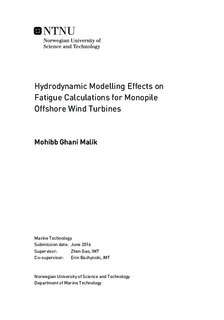Hydrodynamic Modelling Effects on Fatigue Calculations for Monopile Offshore Wind Turbines
Master thesis
Permanent lenke
http://hdl.handle.net/11250/2397919Utgivelsesdato
2016Metadata
Vis full innførselSamlinger
- Institutt for marin teknikk [3431]
Sammendrag
For shallow and intermediate water depths, monopile foundations are the mostcommonly used concept, and is considered the most promising with respect tothe cost of energy. The typical highest structural eigenperiods of these structuresare usually between 3-5 seconds, and often coincide with the wave frequencies.Estimates of the fatigue life is therefore very dependent on accuratehydrodynamic modeling of the wave forces. In these cases, the waves are oftenrelatively short compared to the structure, and the often used Morison s Equationis no longer accurate, as it does not account for diffraction.In this thesis, a comparison between the standard Morison s equation andMacCamy-Fuchs diffraction theory has been performed. The responses and fatiguelife of a 5 MW wind turbine was investigated, using both hydrodynamictheories.The analyses showed that the wind turbine experienced small differencesas a result of the hydrodynamic modeling. Since wave diffraction affects smallwaves, the results were different at different depths. At the mean sea level,MacCamy-Fuchs resulted in approximately 3% lower fatigue damage. However,at the bottom, where only the large waves affect the structure, MacCamy-Fuchsresulted in approximately 3 % higher fatige. This suggests that the wind turbinein question is not very sensitive to diffraction.It was however seen that the fatigue damage was dominated by load caseswith large aerodynamic thrust, suggesting that the structure is more sensitiveto aerodynamic loads than hydrodynamic loads, as should be expected from amonopile structure at shallow water depth.
